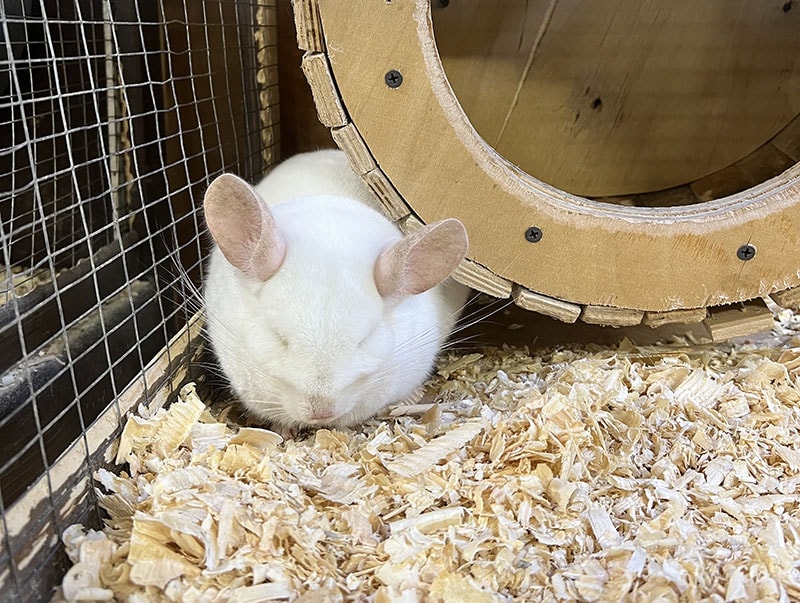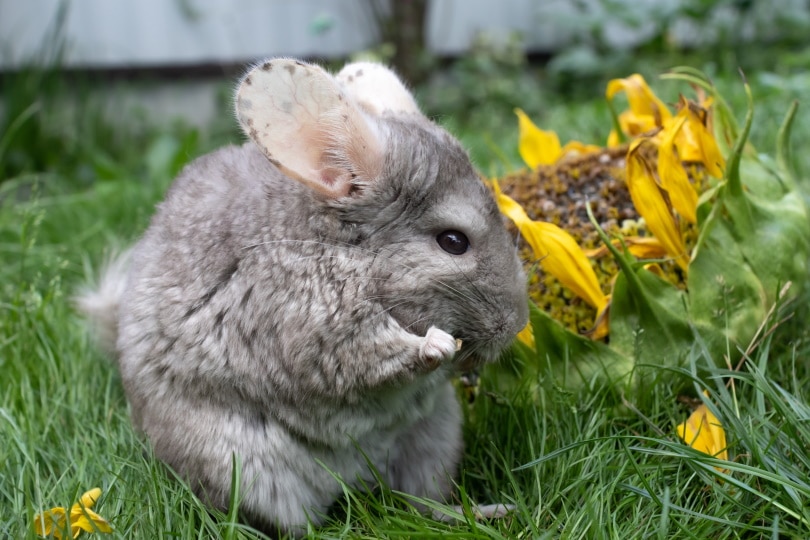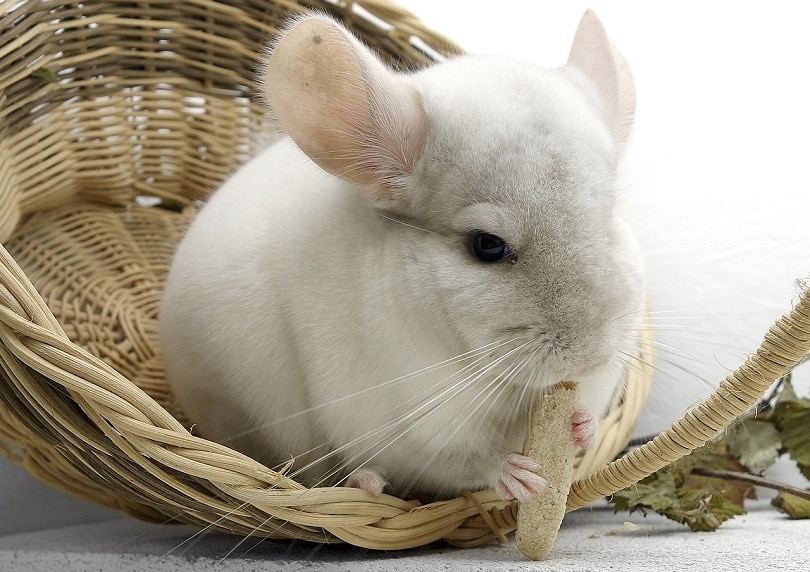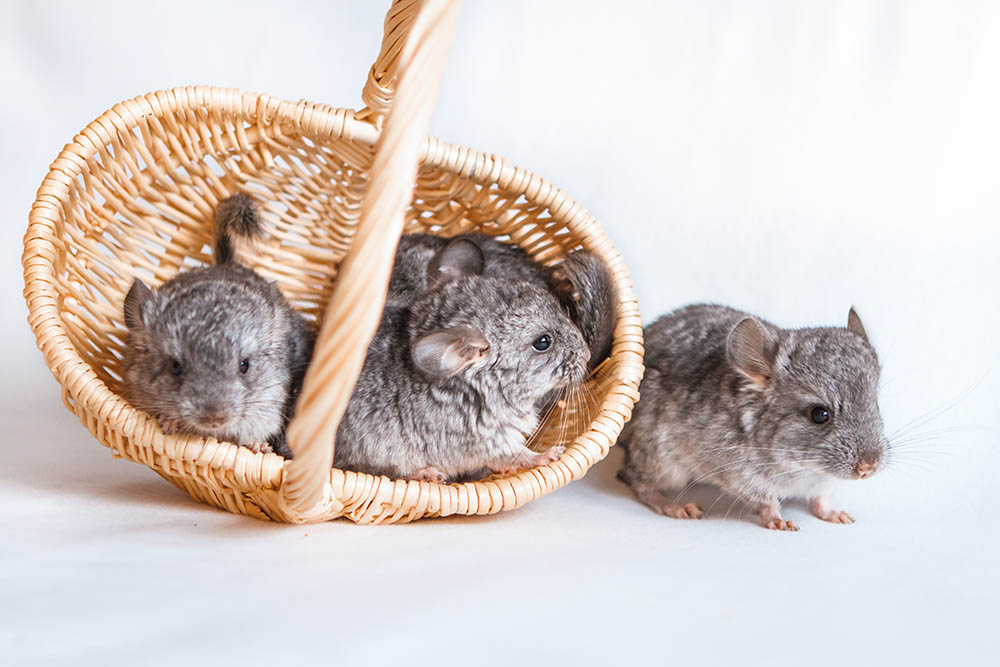
Below, we have included reviews of 10 of the best bedding options for Chinchillas, as well as a guide to help you choose the one that is best for your furry friend.

A Quick Comparison of Our Winners (2024)
| Image | Product | Details | ||
|---|---|---|---|---|
| Best Overall |
 |
Carefresh Small Animal Bedding |
|
Check Price |
| Best Value |
 |
Kaytee Clean & Cozy Small Animal Bedding |
|
Check Price |
| Premium Choice |
 |
Back-2-Nature Small Animal Bedding |
|
Check Price |
 |
Brown’s Naturally Fresh! Animal Bedding |
|
Check Price | |
 |
Kaytee Clean & Cozy Extreme Animal Bedding |
|
Check Price |
The 10 Best Beddings for Chinchillas
1. Carefresh Small Animal Bedding – Best Overall

| Bedding Type: | Recycled Paper |
| Volume: | 60 Liters |
Carefresh Small Bedding is affordable bedding made from recycled paper fiber. It is biodegradable and compostable, which means that the litter can be recycled easily after use. The paper itself will biodegrade and Chinchilla poop is safe to use as mulch and to add to compost, as Chinchillas are herbivores.
Carefresh also claims that the paper is twice as absorbent of liquid as wood shavings and that the bedding is virtually dust free. The competitive price and decent performance of Carefresh Small Animal Bedding make it our choice as the best overall Chinchilla bedding.
However, some bags have been delivered with a chemical smell according to some customers, which means that the bedding may require airing out to avoid this smell circulating around the room.
2. Kaytee Clean & Cozy Small Animal Bedding – Best Value

| Bedding Type: | Recycled Paper |
| Volume: | 85 Liters |
Chinchillas don’t need as much bedding as some other pets, like rabbits, but they can still get through quite a lot. Fortunately, you can buy giant bags of bedding and it will keep, as long as you store it in a cool, dry environment. Buying a large bag means you won’t run out. It also means you can save money compared to frequently buying smaller bags.
Kaytee Clean & Cozy Small Animal Bedding comes in 85-liter bags, and you can even buy it in bundles of two so you will have enough bedding for several months at a time. The bedding itself is made from recycled paper, which the manufacturer claims is 99% dust free, expands to triple the size to absorb 20% more liquid, and can hold as much as four times its own weight in litter. The extra absorbency not only keeps the cage clean but also reduces smells and odor.
The low cost, large volume, and absorbent properties of the Kaytee Clean & Cozy Small Animal Bedding make it the best Chinchilla bedding for the money. However, it is dustier than claimed, which can cause problems for some sensitive Chinchillas and owners.
3. Back-2-Nature Small Animal Bedding – Premium Choice

| Bedding Type: | Recycled Paper Pellets |
| Volume: | 30 Liters |
Paper makes a good bedding material for Chinchillas, hence why it features so heavily on this list of bedding options. It absorbs liquid while being soft and comfortable for your Chin. It is also relatively inexpensive, and if you have a regular supply of suitable paper, you can shred your own bedding without having to buy any. However, the paper needs to be free from ink, in case the Chinchilla tries to eat it, and not everybody has a near-constant supply of used blank paper.
While most recycled paper bedding comes in the form of shredder or ripped paper, Back-2-Nature Small Animal Bedding comes in pellet form. Pellets are compressed, which means that they expand even more than shredded or torn paper, although they can be harsher to stand on. The pellets are also less likely to produce dust, even if they get kicked around the cage. Back-2-Nature Small Animal Bedding is a premium bedding with a high price tag, but it goes a long way and the pellets are easy to spread. They’re also recyclable and compostable, so are easily discarded.
4. Brown’s Naturally Fresh! Corn Cob Small Animal & Bird Bedding

| Bedding Type: | Corn Cob and Paper Twirls |
| Volume: | 5.87 Liters |
Corn cobs make effective bedding and litter because they clump well, they don’t produce dust, and the heavier weight means that they aren’t as easily kicked around the cage or thrown from it. However, the cobs can be quite sharp so they can be uncomfortable for Chinchillas’ feet.
Brown’s Naturally Fresh! Corn Cob Small Animal & Bird Bedding is a combination of corn cobs and paper twirls. The paper twirls add a softer texture so that the bedding isn’t as harsh for your Chinchilla but the cobs still do their job. The corn is also heavy enough that it is unlikely to get stuck in fur so it is useful for those Chinchillas that tend to make a lot of mess.
The paper is also good for your Chin to tear up and use as nesting and bedding material. However, you may want to add a top layer of softer bedding to really make a suitable comfort level. Brown’s is quite an expensive bedding but combining it with a paper or wood shaving bedding also helps minimize the cost a little while retaining the absorbency and other benefits of the corn cobs.
5. Kaytee Clean & Cozy Extreme Odor Control Small Animal Bedding

| Bedding Type: | Cardboard and Paper |
| Volume: | 54 Liters |
Kaytee Clean & Cozy Extreme Odor Control Small Animal Bedding claims to control odors for at least 14 days, and Kaytee even offers a money-back guarantee if it fails to do so. Recycled cardboard and paper combination is six times more absorbent than wood-based bedding. This absorbency not only helps control smells but also keeps the cage drier and more sanitary for your Chinchilla.
The soft recycled paper is comfortable and because it is so soft it can be moved around and your Chinchilla can dig and burrow in it safely. It is modestly priced litter, but despite claims that it is virtually dust free, it does give off some dust, which can be problematic for Chinchillas and owners. Although some of the pieces of paper are colored, the color doesn’t run so it doesn’t stain either your Chinchilla or its cage.
6. Oxbow Pure Comfort Small Animal Bedding

| Bedding Type: | Paper |
| Volume: | 71 Liters |
Paper is a commonly used bedding material and it is possible to make bedding yourself by shredding paper. However, you need to ensure that the paper has never been printed on, because the ink can be toxic to your Chinchilla. Oxbow also claims to have tested the paper to ensure it is free from glue and other by-products of the printing process. The bedding is safe, therefore, and it does expand when wet so it can retain some of the odors. It’s also a very low price and produces minimal dust.
However, while a lot of paper bedding products are textured so that they expand and clump, Oxbow Pure Comfort Small Animal Bedding can get messy when it gets wet, so you need to be on the ball when it comes to removing soiled bedding to ensure a healthy and clean cage environment.
7. Rabbit Hole Hay Ultra Premium Food Grade Paper Small Pet Bedding

| Bedding Type: | Paper |
| Volume: | 7 Cubic Feet |
The quality of the paper really is important when buying shredded paper bedding because while you might not intentionally feed it to your Chinchilla, they do have a tendency to investigate with their mouth and will gladly pick up and eat new bedding to see if it is food. This is especially true if they drop morsels of their food in the bedding.
Rabbit Hole Hay Ultra Premium Food Grade Paper Small Pet Bedding is made using FDA-approved food-grade paper that is free from dioxins and other potentially harmful chemicals. It’s also reasonably priced and doesn’t produce a lot of dust, but this is another shredded paper bedding that looks like shredded tissue, so while each piece is absorbent and swells when it gets wet, it can get messy quite quickly. The cage will need cleaning and the bedding changed quite often.
8. Brown’s Naturally Fresh! Aspen Small Animal & Bird Bedding

| Bedding Type: | Wood Shavings |
| Volume: | 24 Liters |
Wood shavings are a traditional bedding material for small animals like Chinchillas. They’re readily available, they do absorb liquid, and are inexpensive. However, you do need to ensure that you choose the right wood shavings. Aspen is an affordable material used to make bedding and it creates soft bedding, has a natural aroma, and it doesn’t produce a lot of dust. It is also a natural insulator, so your Chinchilla will feel snug, and Aspen is a good choice of wood because it is free from oils that can act as irritants.
Brown’s Naturally Fresh! Aspen Small Animal & Bird Bedding is affordable Aspen bedding but wood shavings do not absorb as much liquid as paper and some other materials. The slightly sharper edges of the wood shavings also mean that they can easily get caught and tangled in fur so the bedding is easily tracked around the cage.
9. Carefresh Sea Glass Small Animal Bedding

| Bedding Type: | Recycled Paper |
| Volume: | 50 Liters |
Carefresh Sea Glass Small Animal Bedding is another recycled paper bedding product from Carefresh. The name sea glass refers to the color of recycled paper. The color is really the only physical difference between this and other Carefresh recycled paper products. The colors can help to hide litter, but that’s not necessarily a good thing if you’re looking to skim and remove waste. And the colored varieties are more expensive than the plain.
The bedding is good quality, though, and it is absorbent, doesn’t produce much dust and it does a good job expanding when it is wet without causing too much of a mess. It is also compostable and recyclable. If you do like colored paper then this is a good choice of bedding, otherwise, you would be better off choosing a plain color because it works out cheaper. The sea glass color isn’t overly expensive, but it does represent a premium compared to the standard color.
10. Natures Premier Small Animal Bedding

| Bedding Type: | Straw |
| Volume: | 1.5 Cubic Feet |
You can use straw as bedding for Chinchillas. It is warm and safe to eat, although straw shouldn’t be fed intentionally or as a substitute for good quality hay. However, it isn’t as absorbent as other materials and doesn’t expand, which means it is ineffective compared to paper or even wood shavings. Straw doesn’t tend to produce dust, although it can have sharp ends that are uncomfortable and potentially even a little painful on Chinchilla’s feet.
Nature’s Premier Small Animal Bedding is a small bale of straw that is compostable, so it is an eco-friendly option, but it is expensive and there are likely better options out there for most Chinchillas and owners.

Buyer’s Guide: How to Select the Best Beddings for Chinchillas
Chinchillas can make great pets. They do tend to be shy but with regular handling, they will at least tolerate being held. They are active and playful, though, which makes them fun to watch and interact with in their cage. They do have specific housing and care requirements, some of which are unique to the species, but they are not considered too high maintenance or especially difficult to look after.
One of the most unusual aspects of Chinchilla ownership is that these small animals need regular dust baths. These help absorb oils and dirt from the Chinchilla. You also need to ensure that the Chinchilla has adequate housing, and, within that housing, it needs good quality bedding to keep it comfortable and warm.
There are plenty of options when it comes to choosing Chinchilla bedding, and below we have included a guide to some of the features.
Bedding Materials
Chinchillas naturally come from the Andes mountains in South America. They live on arid land with very little vegetation. They have very dense fur that does an incredible job of keeping them warm during cold nights in the mountains. They typically sleep in gaps between rocks or under rocks, which means, in the wild, they would sleep on sand or hard surfaces. However, when kept as pets, they benefit from more comfortable bedding. And as a Chinchilla owner, you benefit from giving them bedding that is easy to clean, prevents the ammonia smell that comes from urine, and doesn’t need changing every day.
The main options when it comes to bedding material are:
Paper
Paper is not a natural bedding material, but it is a convenient one. Commercial paper bedding is usually made from recycled paper that has been shredded. It may come in a shredded form or as pellets. Paper is very absorbent and it swells when it gets wet. This combination means that paper can do a decent job of absorbing urine, keeping it away from the cage and your Chinchilla, and it also helps reduce odors. It is also a comfortable option and your Chinchilla may enjoy shredding the paper and using it to make its own bedding.
Wood Shavings
Wood shavings tend to have a nice natural smell, which can be appealing to Chinchillas and are certainly more appealing to owners than the acrid smell of urine. If you do choose wood shavings, try to ensure that you choose aspen shavings. Aspen does not contain the same oils as pine and other woods, which means that it should be safer if your Chin does decide to eat some of its bedding. However, wood shavings can be sharp and you are more likely to have to endure dust from wood shavings than from shredded paper bedding.
Straw
Straw is an option but it is a somewhat contentious one. Straw is natural and it should be safe if your Chinchilla eats a small amount. But the ends of straw can be very sharp. Not only might they hurt to walk on, but they could also jab an eye and cause an injury this way.
Fleece Mats
Fleece mats are another somewhat contentious choice. Fleece is safe to use in a Chinchilla cage, as long as your Chinchilla doesn’t eat it. If your Chin does eat the fleece, it won’t digest and can cause real gastrointestinal problems. However, if it doesn’t eat the fleece, it can be taken out, washed, and reused, and it does a good job of keeping the cage fresh and clean without the need for too-frequent cleaning.

Features
Whatever material you choose, there are various factors to consider.
Absorbency
Although Chins can be litter trained, even trained Chinchillas have accidents. This means that wee and poop will get into the bedding. This can cause odors and it can lead to your Chinchilla getting dirty. Surprisingly, urine is the biggest problem because it can start to smell of ammonia, which has an acrid and strong smell. Good litter absorbs liquids, including urine. This not only prevents the urine from getting onto the floor of the cage but it can also prevent the smell from spreading and festering. Paper tends to absorb urine very well, while wood shavings can do a good job, too.
Dust
Wood shavings do give off some dust and while most paper products don’t, this isn’t necessarily true of all. Dust can be a real problem for Chinchillas and their tiny lungs, and it can also be an issue if you or a family member has respiratory problems. Look for litters with low dust levels to avoid this.
Compostable
Typically, you will sift the bedding daily and remove solids and clumped bedding, completely swapping out the bedding every week when you clean the cage. This means throwing away a cage of bedding every week. Most wood and paper are compostable and biodegradable, and Chinchilla poop actually makes good mulch and can even be put in the compost. If you want to minimize your impact on the environment look for biodegradable or compostable litter and ensure you dispose of the bedding properly every time you clear it out.
Safe To Eat
Chinchillas love to chew, and this isn’t always reserved for food and chew toys. Some Chinchillas will seemingly chew anything. This may include bedding, and even if your Chin doesn’t intentionally eat the bedding you choose, it may pick some up inadvertently while hoovering up spilled food. Ensure the bedding you choose is safe to eat. Paper does expand and this can lead to impaction in the gut if too much is consumed. Wood shavings, although they don’t expand as much, can have sharp edges that may cause damage or pain on the way down.


FAQs
Can You Litter Train a Chinchilla?
It is possible to train a Chinchilla to use a litter tray, but it is often only possible to train them to urinate in a litter tray. This is because Chinchilla poop does not have a smell and Chinchillas will poop anywhere. Their urine has a strong smell, and with some time and patience, it is possible to have your Chin urinate in a litter tray to minimize mess and make clean up much easier.
How Much Bedding Should I Give My Chinchilla?
Provide between 1 and 2 inches of good quality bedding throughout your Chin’s cage. They may choose to move some of it around themselves so that they have more or less in specific areas.
How Often Should You Change Chinchilla Bedding?
You can sift bedding daily to remove solids and any clumped, wet bedding. Every week, you should completely remove the bedding and provide fresh bedding after washing and drying the cage. This will help ensure your Chinchillas have a safe and pleasant environment in which to live.
Should I Cover My Chinchilla’s Cage At Night?
Chinchillas are prey animals and they like to have a good view of their surroundings. Covering their cage, even at night, can prevent this and may actually scare your Chin or cause stress and anxiety. Covering the cage can also interfere with their understanding of the time of day and the day/night cycle so it should be avoided.

Conclusion
Chinchillas need comfortable bedding that provides warmth and is safe for them. The bedding should also be easy for you to manage so that you can ensure your Chin’s living environment is kept fresh and clean. Getting the right bedding is important. Using the reviews and guide above, you should be able to choose a bedding that is ideal for your Chinchilla and you.
We found Carefresh Small Animal Bedding to be absorbent and good at controlling odors while also being a good price. If you’re looking for a real bargain, Kaytee Clean & Cozy Small Animal Bedding is really absorbent although not as dust-free as the manufacturer claims.
You Might Also Be Interested In:
Featured Image Credit: Denis Tabler, Shutterstock










